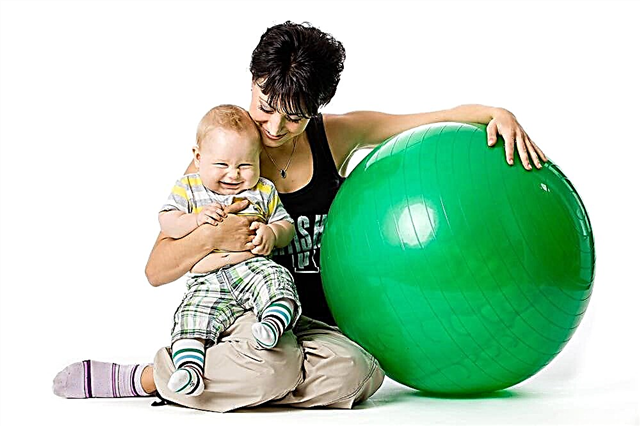The human organs of vision are a very delicate, vulnerable structure, especially in the first year of life. If parents notice red eyes in a newborn, then this is a sign that something is wrong.

Red eyes in a baby
Why do the eyes of a newborn turn red
The outside human eye consists of:
- Sclera;
- Irises;
- Pupil.
The sclera is a tunica albuginea, which is also called a protein. Normally, it should be white. Thin blood vessels - capillaries - can appear on it. As a rule, they are hardly noticeable.
If yellowness or redness appears on the protein, this is an alarming symptom, especially for a newborn baby. The crumbs, for sure, have some problems, and he needs help. The causes of redness and yellowness are too different, therefore today we will only talk about the first of the symptoms.
This phenomenon can be considered normal in some cases. For example, a newborn has red eyes immediately after giving birth. This happens if the thin vessels burst - passing through the birth canal, children experience strong pressure. In this case, redness is not observed in the entire eye, but in the form of dots - where microbleeding occurred. This is not scary, does not require medical intervention, as a rule, by the time of discharge it has already passed.
Note! If the mother's eye condition seems abnormal to her baby, she should consult with the pediatrician on the round.
Usually, if redness appears, then something is wrong. The reasons may be:
- Dacryocystitis. This is a blockage of the lacrimal canal with a gelatinous plug, which causes inflammation of the lacrimal sac. Redness spreads from the inner corner of the eye to the lower eyelid.

Dacryocystitis
- Conjunctivitis. The conjunctiva becomes inflamed, due to which the vessels become highly visible, and the sclera - pink or red. Conjunctivitis can be viral, bacterial, or allergic. In the first case, it is contagious, as it arises from an infection. The cause of the bacterial is the ingress of dirt into the eye (which happens with improper care). These two options are only possible on one side, on one eye. With allergic conjunctivitis, pus appears less often. But it applies to both eyes at once.
- Injury. This can include prolonged crying, for example, with colic. Then, like a newborn, red dots appear, the capillaries in the child's eyes burst from overstrain. The same can happen from a blow.
- Lack of sleep. A slight redness indicates that the baby was woken up too early.
- Foreign bodies. A red eye in a baby happens if an irritating object gets under the eyelid: a speck of dust, an eyelash, a small particle. An adult understands that it is interfering and needs to be removed. Kid - no. When blinking, a foreign body rubs the mucous membrane, inflammation occurs.
- Blepharitis In this case, redness spreads along the eyelid, corner of the eye. This is a viral disease.
- Uveitis. This is the name of the inflammation of the choroid. If left untreated, statistics say that in 25% of cases it ends in complete blindness.
- Glaucoma. This is the name of a disease in which pressure increases inside the eye.
Additional symptoms
If the baby's eye turns red, this is usually accompanied by additional symptoms. By their combination, you can understand what the problem is:
- With dacryocystitis, there may be inflammation of the area around the inner corner of the eye, edema. In advanced cases - acute pain on palpation.
Attention! Dacryocystitis is diagnosed shortly after birth. The disease develops in the first days, weeks (up to a month of life). The gelatin plug must come off. If not, during the examination, the doctor will either prescribe some medications in conjunction with a special massage, or, if the situation is difficult, recommend surgery.
- Conjunctivitis is a common disease in children. Its difference is purulent discharge. They happen with a viral or bacterial infection. In the first case, they are accompanied by acute pain, photophobia, lacrimation. This is a common complication of ARVI, flu, infections. With bacterial conjunctivitis, the pus is thicker, viscous, sticky. There can be so much of it that it is difficult to open your eyes. With an allergic reaction, there is usually no discharge. But there is profuse tearing, swelling of the eyelids, a runny nose with the release of a large amount of secretion, and both in sleep and in wakefulness.

Pus with conjunctivitis
- With an injury, the baby usually does not bother. The red vessels in the eyes of the child are more noticeable, there are dots, but there is no reddening of the protein.
- Lack of sleep, as in an adult, is accompanied by poor appetite, irritability, moodiness, lethargy.
- If the baby has a red eye due to a foreign object, the baby will often blink, rub his eyes with his pens. Tearing may appear.
- Blepharitis is a dangerous disease. Swollen, inflamed eyelids hurt, which gives the baby discomfort.
- With uveitis, symptoms that parents may note are lacrimation and photophobia of their child. The child himself will not see well - the "fog" in front of his eyes will interfere.
- With congenital glaucoma, tears also flow for no reason, light hurts. In addition, the eyeball itself is enlarged. Other symptoms will be noticed by the doctor: a deepening of the anterior chamber of the eye, corneal edema, changes in the optic nerve head.
How parents can help
Normally, parents should pay attention to the condition of the children's eye daily. The first thing that can protect you from pathology is proper hygiene. Be sure to follow these rules:
- To wash hands. An infection from the palms of an adult can easily get into the eye of the baby. Since the immunity of a small person is still weak, it will almost certainly entail infection with all the ensuing consequences.

Hands wash with soap
- They don't put their hands, a cotton pad, a handkerchief into their eyes for the same reason. Only a sterile object is used to cleanse the eyes of a newborn.
- For crumbs up to a month of life, crusts may appear in the corners of the eyes and on the eyelids. If this proceeds without inflammation, and the crusts are not pus, then this is normal. You can gently moisten them with a sterile napkin (these are sold at the pharmacy) and just remove them carefully. To make the crusts come off better, you can remove them not only in the morning, but also after taking a bath, when they soften.
- Water for cleansing should be boiled and cooled to room temperature. Sterile saline can also be used.
- The eyes are cleaned from the inner corner of the eye to the outer corner. The child lies on his back.
If there is already inflammation, the baby's eyes turn red, then parents at home can help like this:
- Assess the baby's condition. If the baby is very restless, cries non-stop, he has a temperature, then this is a reason to call an ambulance. If the mother and the baby are still in the hospital, urgently call the pediatrician on duty. In the case when the child's condition allows him to wait, they make an appointment with an ophthalmologist as soon as possible. When the appointment is not yet soon, they go to the clinic to see the pediatrician on duty. He, if necessary, will redirect to a live queue to a narrow-profile specialist.

Examination of the baby's eyes by an ophthalmologist
- With bacterial conjunctivitis, the pus should be removed from the eyes. This is done either with saline or furacilin solution.
- If the baby has a red eye due to the ingress of a foreign body, it must be rinsed. In this case, such a movement helps: gently hold the lower eyelid with a finger and, without letting it go, draw in one movement in a circle from the outer corner of the eye to the inner one. Press, you cannot press. This will move the dirt to a corner where it can be easily accessed.
- Redness due to overwork, lack of sleep is a reason to put the baby to bed early.
- The light may need to be adjusted. It may be too bright, and it irritates the eyes of the crumbs.
- Eliminate allergens from food and household items. It can be citrus eaten by a nursing mother, or dust, for example.
What not to do
The first thing mom and dad might think about if their baby has red eyes is that they need to be dripped with something. This is a totally wrong action. Here is a list of what not to do:
- In no case should you drip something into the baby's eyes. If this is a medicine, it can be at least useless, at the most it can harm even more. Other liquids, except for those permitted, are prohibited to pour there. Many mothers are interested in why it is considered harmful to drip breast milk, as was the custom in the last century. Doctors answer: it is the best food for the baby, but also an excellent breeding ground for bacteria.

Breast milk for baby food, not eye drops
- Warm up a sore spot. This is often advised to do by modern grandmothers brought up in the conditions of Soviet medicine. This is dangerous with complications: in a warm environment, viruses, pathogenic bacteria do not disappear, on the contrary, they multiply better.
- Prescribe treatment yourself. If the mother is not a doctor, it is better to treat the baby not on your own. Only a specialist (pediatrician or ophthalmologist, depending on the severity of the case) can soberly assess the need for medication, physiotherapy, massage.
Important! Antibiotics should be avoided unless prescribed by a healthcare professional. Yes, some diseases are treated with them. But with bacterial conjunctivitis or dacryocystitis, they will be useless, since only viruses are effectively eliminated.
In any case, if the baby has red eyes and it worries him, the best thing a mother can do is to visit a doctor. Then everything will depend on what is the cause of the children's discomfort. The doctor will prescribe treatment, adults must strictly follow all his prescriptions.



